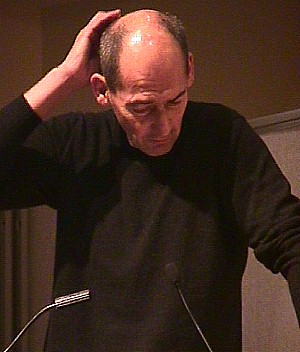Lauf on Unbuilding
from an (online list) interview June 1999
...I have been constructing computer models of unbuilt designs since 1987. at the time I was a rare 3-d cad specialist and I had my own cad system to do with what I wanted. I wanted to see what certain unbuilt designs were like, so I built computer models of them. by the early 1990s, I looked upon my model building activity as generating a kind of museum of architecture. by 1996, I had accumulated a sizable collection and saw opportunity in the internet of (finally) creating an actual virtual museum of architecture, so that's what I did.
...Almost all of my work presently (and for the last 2.5 years) has centered on Quondam, and therefore the issue of "architecting" a virtual building using 2-dimensions is the process that I am currently executing.
...Digital media does indeed take on multitudinous forms and holds voluminous content, and thus the context of my work is small in comparison. Specifically, I deal with "digitally translating" architecture(s) via a (web)site in cyberspace utilizing simple hypertext markup language (HTML) files that often include individual image files. The media I use to maintain a virtual architectural environment are limited, but not limiting. In terms of programming sophistication, what I do is at the low end of web technology, and I purposely remain there to keep my delivery of data as universal as possible. For example, I prefer to not offer a message requiring capabilities beyond the average web browser. Some designers, or perhaps most designers consider the capabilities of basic HTML and basic web browsers as undesirable or unnecessary creative barriers. I believe there is an inherent fallacy in such thinking because all data, once it becomes digital, acquires the attribute of (virtually) infinite possibilities, and, therefore, creativity within the digital realm can automatically explore a considerably wide berth, even if only using the most common computer-aided means. Simply put, I work within the more common digital infinities.
...The term "aesthetic revelation" brings to mind the topless bathing-suit for women -- the aesthetics and revelation there are self-evident. I'm not exactly sure, however, how the same term applies to my work. If my work incorporates an aesthetic, that aesthetic then stems from investigating digital media's infinity through seemingly limited mechanisms. Most recently, I have become fond of the notion that "space" within cyberspace is always readily abundant, and, via hyperlinks, movement and circulation from "space" to "space" is easily facilitated. Moreover, hyperlink transitions within cyberspace offer the same abundant possibilities as the "space" itself since any channel or passage is instantly creatable. Because of this abundance, I do not regret cyberspace's basic lack of the third dimension. Indeed, generating a real cyber space and a real virtual place utilizing only two dimensions is our time's greatest architectural challenge.
...Since I can at present validly refer to myself as a 'digital architect', I will likely be able to refer to myself as a 'digital architect' in the future as well. I certainly hope that architects begin to better understand the limitless potentials of a "design but not build" architectural profession. Of course, since this career option is still very new, experience, as opposed to formal education, is more or less still the only real way to become a digital architect.
| |
Koolhaas on Unbuilding
from an (WIRED) interview June 2000
..."We never say, 'We do beautiful things with light,'" one told me. Having designed a studio explicitly devoted to making buildings that function as solutions to carefully analyzed problems - a studio, in other words, whose aesthetic is not formal but organizational - Koolhaas perceived that he could now go further, to the speculation that architectural concepts have marketable value even if concrete is never poured. Perhaps
especially if concrete is never poured.
This realization was powerful enough to convince Koolhaas to split his studio in two. OMA will continue to design buildings and plan cities, while AMO (the mirror image of "OMA," rather than an acronym in its own right) will focus on what Koolhaas calls virtual architecture. He's not talking about buildings designed on a computer, though, or about visual representations of databases, or about MUDs. To Koolhaas, virtual architecture means designs or redesigns of human environments that don't resort to the tools of the construction industry: "My ambition is to modernize and reinvent the profession by making use of our expertise in the unbuilt," he says.
"The unbuilt is the fantasy that underlies everything," he says. "How do you engineer undesign? It is hard to make it credible, but AMO will yield to building only when it is shown to be absolutely necessary."
For Koolhaas and OMA, virtual architecture kills three birds with one stone: It offers payment for concepts instead of concrete. It delivers something to clients that matches the velocity of their demands. And most important, it supplies an ingenious antidote to claustrophobic global development.
But Koolhaas has not found a promised land in the world of the virtual. It turns out that the virtual, too, is full of junk. Arcades go up over streets in Las Vegas, city squares are encased in giant screens, GPS systems promise that digital signage will follow you even into the middle of the desert. The superficial variety and fundamental monotony of junkspace is, if anything, even more extreme in virtual space. Moreover, the virtual and the physical incarnations support each other in a mutual feedback loop: As physical territory is absorbed into junkspace, the glow of the computer and the PDA becomes a cheap replacement for the vanishing natural world. "The already considerable vastness of junkspace is extended to infinity in virtual space," Koolhaas writes. "Conceptually, each monitor, each TV screen is a substitute for a window; real life is inside, cyberspace has become the great outdoors."
|
